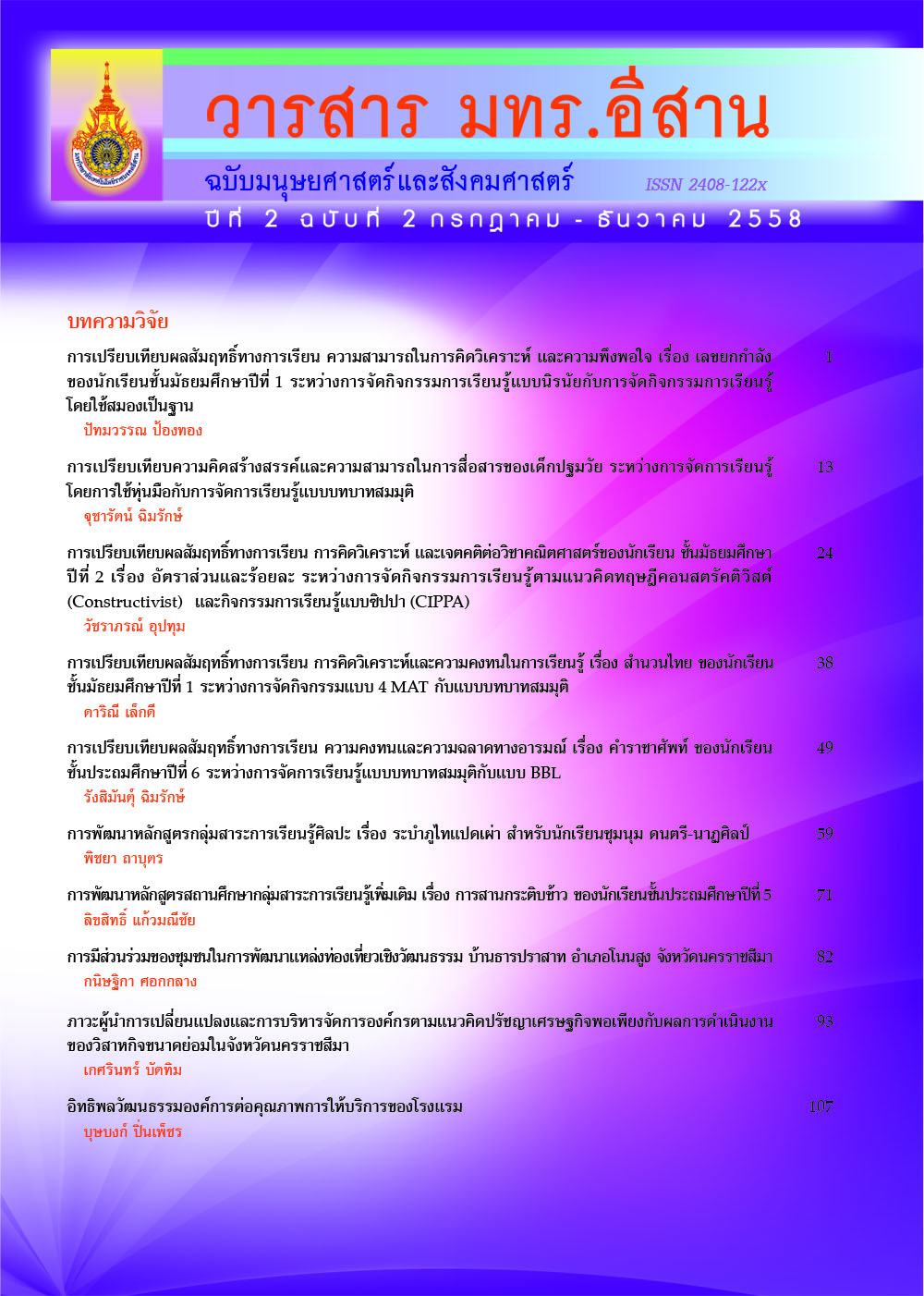The Comparison of Learning Achievement, Analytical Thinking and Attitudes toward Mathematics Entitled Ratio and Percentage of Matthayomsueksa 2 Students Between Using Constructivist Learning Activities and CIPPA Learning Activities
Main Article Content
Abstract
The purpose of this research were 1) To determine the understanding of ratio and percentage by Grade Matthayamsuksa 2 High School students who learned from the Constructivist method and from the CIPPA method relative to the 75/75 standard. 2) To study the effectiveness index of learning by Grade Matthayamsuksa 2 High School students learning ratio and percentage using the Constructivist method and the CIPPA method. 3) To compare student achievement in analytical thinking and attitude towards mathematics by Grade Matthayamsuksa 2 High School students who learned about Ratio and Percentage using the Constructivist method with students who learned using the CIPPA method by using a pre-test and post-test. The sample for this research was 50 students in Grade Matthayamsuksa 2 at Chiangyuanwittaya School. These 50 students were selected in semester academic year 2013 by purposive sampling. The research tools used in this study were lesson plans about ratio and percentage using the Constructivist method and the CIPPA method. The test for student achievement in ratio and percentage for Grade Matthayamsuksa 2 mathematics students were a criteria referenced test. It was a multiple choice test of 40 questions. The difficulty values (p) ranged from 0.28 to 0.71, discrimination values (B) from 0.32 to 1.00 and the coefficient of reliability was 0.85. The measure of attitude towards mathematics was performed by using a 5 level Rating Scale with 15 questions. The difficulty values (p) ranged from 0.38 to 0.74, discrimination values (B) from 0.26 to 0.89 and the coefficient of reliability was 0.95. The measure for analytical thinking was a multiple-choice test of 30 questions. The statistics used in the data analysis were percentage, mean, and standard deviation. T-test was used to test the hypothesis.
The results were as follows
1. The Constructivist method and CIPPA method had an efficiency of 78.28/75.40 and 78.24/75.20. Both learning methods were higher than the 75/75 standard.
2. The effectiveness index for learning activities with Constructivist theory and CIPPA were 0.7166 and 0.6630, or 71.66 and 66.30 percent respectively. It showed that students had progressed in learning with both methods used in the study.
3. The post-tests showed that the students who learned with Constructivist method and students who learned with CIPPA method both achieved higher scores in student achievement, analytical thinking, and attitude towards mathematics, which was statistically significant at level 0.05.
4. The students who learned with Constructivist method achieved higher scores in analytical thinking and attitude towards mathematics than the students who learned with CIPPA method, which was statistically significant at level 0.05.
Article Details
บทความที่ได้รับการตีพิมพ์เป็นลิขสิทธิ์ของมหาวิทยาลัยเทคโนโลยีราชมงคลอีสาน
ข้อความที่ปรากฏในบทความแต่ละเรื่องในวารสารวิชาการเล่มนี้เป็นความคิดเห็นส่วนตัวของผู้เขียนแต่ละท่านไม่เกี่ยวข้องกับมหาวิทยาลัยเทคโนโลยีราชมงคลอีสานและคณาจารย์ท่านอื่นๆในมหาวิทยาลัยฯ แต่อย่างใด ความรับผิดชอบองค์ประกอบทั้งหมดของบทความแต่ละเรื่องเป็นของผู้เขียนแต่ละท่าน หากมีความผิดพลาดใดๆ ผู้เขียนแต่ละท่านจะรับผิดชอบบทความของตนเองแต่ผู้เดียว
References
กาญจนา คำจีนะ. (2551). ผลการจัดการเรียนรู้แบบซิปปา เรื่อง ความหลากหลายทางชีวภาพ สำหรับนักเรียนข่วงชั้นที่ 4 โรงเรียนจุฬาภรณราชวิทยาลัย เขียงราย. การศึกษาค้นคว้าอิสระ การศึกษามหาบัณฑิต เชียงใหม่ : มหาวิทยาลัยเชียงใหม่
ญฤดี แซ่ล้อ. (2543). ศึกษาการจัดการเรียนการสอนวิทยาศาสตร์ โดยใช้รูปแบบการเรียนการสอนซิปปาที่มีต่อผลสัมฤทธิ์ทางการเรียน ทักษะกระบวนการทางวิทยาศาสตร์ เละเจตคติทางวิทยาศาสตร์ของนักเรียนชั้นประถมศึกษาปีที่ 5. วิทยานิพนธ์ปริญญาครุศาสตร์ มหาบัณฑิต กรุงเทพฯ : จุฬาลงกรณ์มหาวิทยาลัย
ทิศนา แขมมณี. (2542). การจัดการเรียนการสอนโดยยึดผู้เรียนเป็นศูนย์กลาง: โมเดลขิปปา (CIPPA Model). วิชาการ. 2(5) : 2-29
นิตยา โสตทิพย์. (2551). การเปรียบเทียบผลสัมฤทธิ์ทางการเรียนและทักษะกระบวนการทางวิทยาศาสตร์ของนักเรียนขั้นประถมศึกษาปีที่ 3 ที่ได้รับการจัดการเรียนการสอนเเบบชิปปากับเเบบปกติ. วิทยานิพนธ์ ค.ม. นครศรีธรรมราช : มหาวิทยาลัยราชภัฏนครศรีธรรมราช
บุษบา แสงลี. (2552). การจัดกิจกรรมการเรียนรู้แบบซิปปา กลุ่มสาระกาวเรียนรู้วิทยาศาสตร์ เรื่องน้ำเพื่อชีวิต ชั้นมัธยมศึกษาปีที่ 2. ศึกษาคันคว้าอิสระ การศึกษามหาบัณฑิต มหาสารคาม : มหาวิทยาลัยมหาสารคาม
ประสาท เนื่องเฉลิม. (2550). การเรียนรู้วิทยาศาสตร์แบบสืบเสาะ 7 ขั้น. มหาสารคาม : วารสารวิชาการคณะศึกษาศาสตร์ มหาวิทยาลัยมหาสารคาม
พิกุล ตระกูลสม. (2552). การวิจัยปฏิบัติการพัฒนากิจกรรมการเรียนรู้ที่เน้นผู้เรียนเป็นสำคัญ วิชาวิทยาศาสตร์ เรื่อง โลกและการเปลี่ยนแปลงโดยรูปแบบขิปปา (CIPPA Model) ขั้นมัธยมศึกษาปีที่ 2 โรงเรียนที โอ เอ วิทยา (เทศบาล 1 วัดคำสายทอง) อำเภอเมือง จังหวัดมุกคาพาร. วิทยานิพนธ์ศิลปศาสตรมหาบัณฑิต อุบลราชธานี : มหาวิทยาลัยอุบลราชธานี
ภาวิณี คำชารี. (2540). การเปรียบเทียบความสามารถการแก้โจทย์ปัญหาคณิตศาสตร์ เรื่อง เศษส่วนทศนิยมและการคิดวิเคราะห์ ระหว่างวิธีเรียนแบบร่วมมือเทคนิค STAD สอดเเทรกเมตาดอกนิชั่น วิธีเรียนตามเเนวทฤษฎีคอนสตรัคติวิสต์ วิธีเรียนตามคู่มือ สสวท. ของนักเรียนมัธยมศึกษาปีที่ 1. ปริญญานิพนธ์ กศ.ม. กรุงเทพฯ : มหาวิทยาลัยศรีนครินทรวิโรฒ
วิมลรัตน์ สุนทรโรจน์. (2549). นวัตกรรมเพื่อการเรียนรู้. มหาสารคาม : คณะศึกษาศาสตร์ มหาวิทยาลัยมหาสารคาม
วิมลรัตน์ สุนทรโรจน์. (2551). นวัตกรรมเพื่อการเรียนรู้. คณะศึกษาศาสตร์ มหาวิทยาลัยมหาสารคาม
วิไลพร ภูดอกไม้. (2552). การพัฒนาการจัดการเรียนรู้แบบชิปปา (CIPPA) ประกอบชุดกิจกรรมการเรียนรู้วิทยาศาสตร์ ขั้นมัธยมศึกษาปีที่ 1 โรงเรียนบ้านดินจี. การศึกษาค้นคว้าอิสระ การศึกษามหาบัณฑิต มหาสารคาม : มหาวิทยาลัยมหาสารคาม
สถาบันส่งเสริมการสอนวิทยาศาสตร์และเทคโนโลยี. 2548). คู่มือวัดผลประเมินผลคณิตศาสตร์. กรุงเทพฯ : โรงพิมพ์คุรุสภาลาดพร้าว
สิรินุช ธรรมนิยม. (2553). การพัฒนาการจัดกิจกรรมการเรียนรู้คณิตศาสตร์เเบบชิปปา (CIPPA Model) กลุ่มสาระการเรียนรู้คณิตศาสตร์ เรื่อง เศษส่วนและทศนิยม ขั้นประถมศึกษาปีที่ 4. ศึกษาค้นคว้าอิสระการศึกษามหาบัณฑิต มหาสารคาม : มหาวิทยาลัยมหาสารคาม
สุพินญา คำขจร. (2550). การเปรียบเทียบผลการเรียนด้วย CIPPA กับ CIPPA ที่จัดกลุ่มแบบ TAI ที่มีต่อผลสัมฤทธิ์ทางการเรียน ความสามารถการคิดวิเคราะห์และความพึงพอใจของนักเรียนระดับประกาศนียบัตรวิชาชีพ. การศึกษาค้นคว้าอิสระ กศ.ม. มหาสารคาม : มหาวิทยาลัยมหาสารคาม
สุริยันต์ สายหงส์. (2550). การเปรียบเทียบผลสัมฤทธิ์ทางการเรียน เละเจตคติต่อการเรียนคณิตศาสตร์ เรื่อง ตัวประกอบของจนวนนับของนักเรียนชั้นประถมศึกษาปีที่ 6 ที่เรียนด้วยการจัดกิจกรรมการเรียนรู้ เเบบ4 MAT และแบบ CIPPA. วิทยานิพนธ์ กศ.ม. มหาสารคาม : มหาวิทยาลัยมหาสารคาม
อรุณี ทองปัน. (2550). การพัฒนาการจัดกิจกรรมการเรียนรู้ตามรูปเเบบขิปปา (CIPPA Model). ศึกษาค้นคว้าอิสระ การศึกษามหาบัณฑิต อุบลราชธานี : มหาวิทยาลัยอุบลราชธานี


